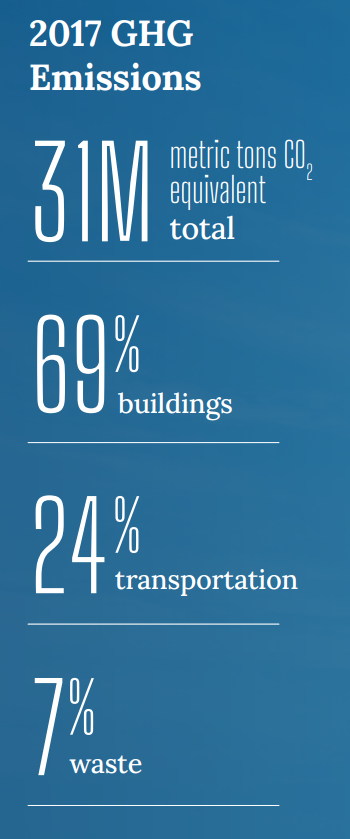Electrify Chicago
An independent tool for viewing City of Chicago building data
According to the
2022 Chicago Climate Action Plan,
69% of Chicago's emissions come from buildings, making
building emissions our biggest challenge and our biggest opportunity as a city
to tackle climate change. At Electrify Chicago, we showcase building performance using
publicly available data supplemented by community-submitted photographs and building
owners.
Start by looking at Chicago's buildings with the highest greenhouse gas intensity i.e. emissions per square foot. Large, efficient, buildings can perform much better than very inefficient small buildings on this metric.
New Article
📰 $30 Million In Missed Fines
The City Of Chicago failed to collect $30 million in potential fines from the building benchmarking ordinance, reducing transparency and accountability.
Legislative update! 🎉
As of late January 2024, legislation is being introduced to require new use more efficient forms of water and space heating, via the Clean And Affordable Buildings Ordinance (CABO), which will reduce the number of highly polluting and inefficient buildings that end up on this site.
If you're in Chicago,
write to your alderman to support the CABO!
Chicago Buildings by Greenhouse Gas Intensity
Note: Data includes large Chicago buildings with data from 2022, unless explicitly stated otherwise.
Note: This data only includes buildings whose emissions are reported
under the
Chicago Energy Benchmarking Ordinance. According to the City “As of 2016,
this list includes all commercial, institutional, and residential buildings larger than
50,000 square feet.” This dataset is also then filtered to only buildings with
reported emissions > 1,000 metric tons CO2 equivalent.
The latest year of data is from 2022, but we update the site regularly when new data is available, and some buildings may have failed to report that year, and only have older data available.
| Property Name / address | Primary Property Type |
Greenhouse Gas Intensity (kg CO2 eq./sqft) |
Total Greenhouse Emissions (metric tons CO2 eq.) |
|---|---|---|---|
|
Heritage Woods of Chicago
2800 W Fulton St
| Senior Living Community | 8.3 kg/sqft
Highest 23%
| 610 tons
Lowest 34%
|
|
UNO Veterans Memorial Campus (Charter School)
4248 W 47TH ST
| K-12 School | 8.3 kg/sqft
Highest 23%
| 1,445 tons
Highest 33%
|
|
118 S Clinton St
118 S Clinton St
| Office | 8.3 kg/sqft
Highest 23%
| 652 tons
Lowest 37%
|
|
Clinton, Dewitt -CPS
(CPS)
6110 N Fairfield Ave
| K-12 School | 8.3 kg/sqft
Highest 23%
| 1,135 tons
Highest 41%
|
|
Gray Elementary -CPS
(CPS)
3730 N Laramie Ave
| K-12 School | 8.3 kg/sqft
Highest 23%
| 1,077 tons
Highest 43%
|
|
Chappell, Eliza Elementary -CPS
(CPS)
5145 N Leavitt St
| K-12 School | 8.3 kg/sqft
Highest 23%
| 727 tons
Lowest 42%
|
|
Catalpa Gardens Condominium Association
1122 W Catalpa Ave
| Multifamily Housing | 8.3 kg/sqft
Highest 23%
| 1,362 tons
Highest 35%
|
|
Bridgeport Homes
(CHA)
844 W 32nd St
| Multifamily Housing | 8.3 kg/sqft
Highest 23%
| 922 tons
Highest 48%
|
|
Kinzie Park Tower Condominium Association
501 N Clinton St
| Multifamily Housing | 8.3 kg/sqft
Highest 23%
| 2,410 tons
Highest 19%
|
|
1111 S. Wabash Condominium Association
1111 S Wabash Ave
| Multifamily Housing | 8.3 kg/sqft
Highest 23%
| 3,358 tons
Highest 12%
|
|
Bernard Horwich Building
3003 3033 W TOUHY AVE
| Mixed Use Property | 8.3 kg/sqft
Highest 23%
| 1,382 tons
Highest 34%
|
|
1220 N STATE PKWY
1220 N STATE PKWY
| Multifamily Housing | 8.3 kg/sqft
Highest 23%
| 824 tons
Lowest 47%
|
|
Park Plaza | A Jewish Senior Living Community
6840 N SACRAMENTO AVE
| Senior Living Community | 8.3 kg/sqft
Highest 23%
| 1,242 tons
Highest 38%
|
|
6 W HUBBARD ST
6 W HUBBARD ST
| Office | 8.3 kg/sqft
Highest 23%
| 547 tons
Lowest 30%
|
|
Reside on Morse
1340 W MORSE AVE
| Multifamily Housing | 8.3 kg/sqft
Highest 23%
| 518 tons
Lowest 28%
|
Data Source:
Chicago Energy Benchmarking Data
